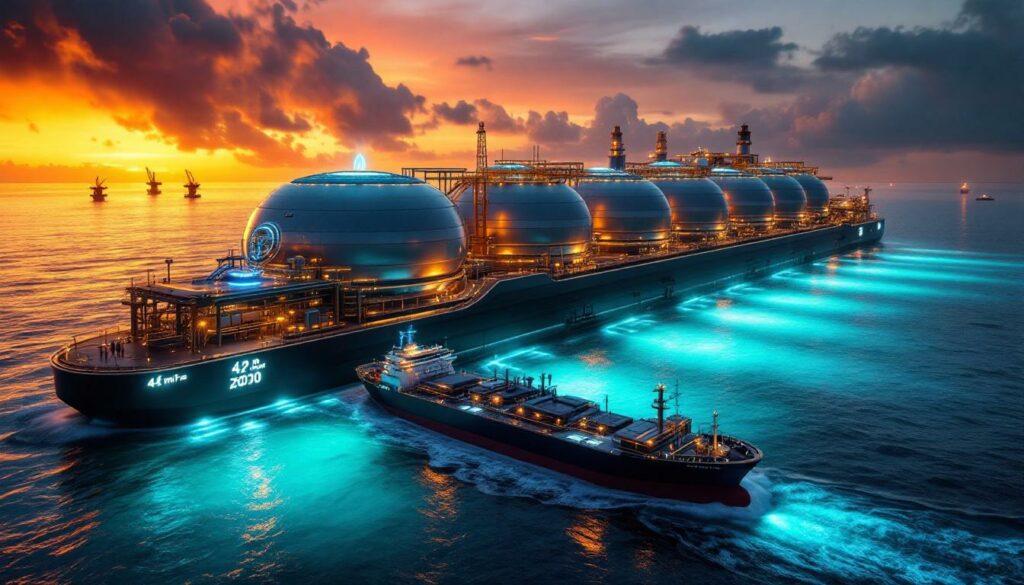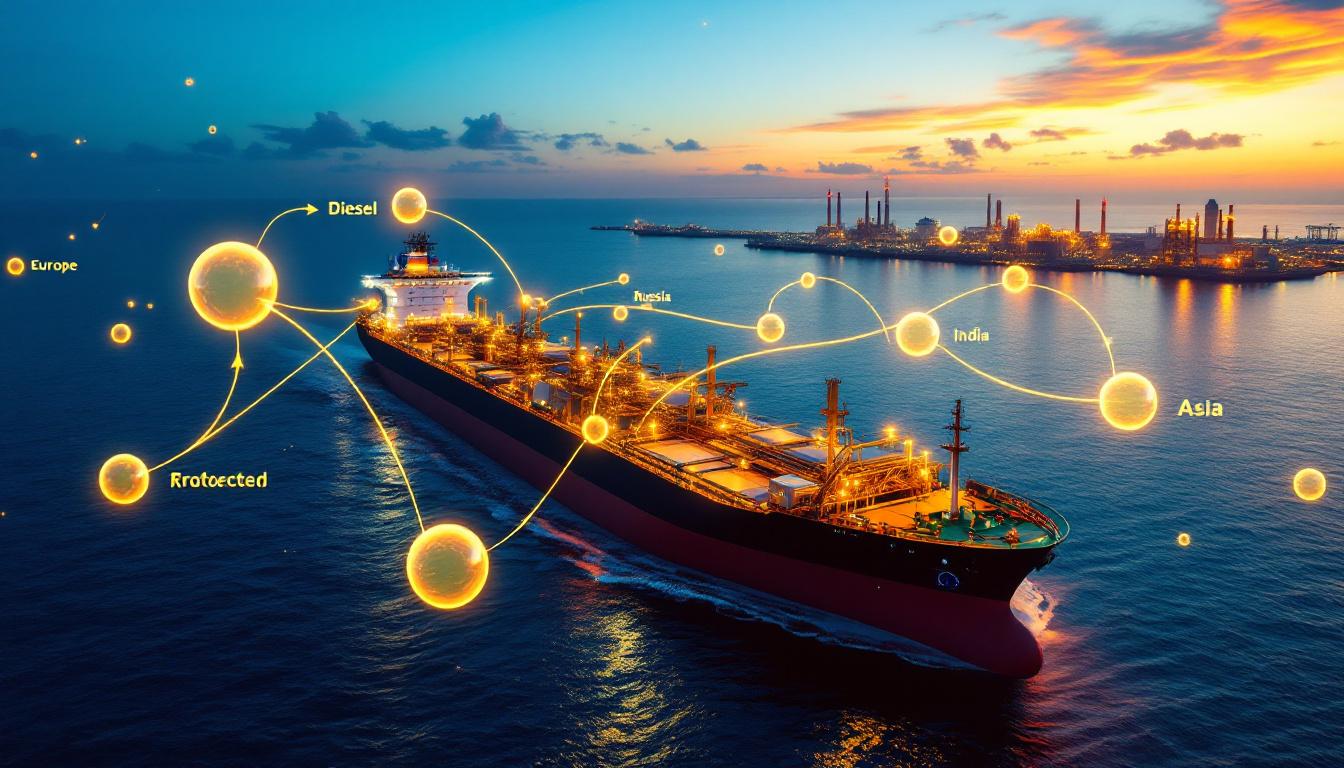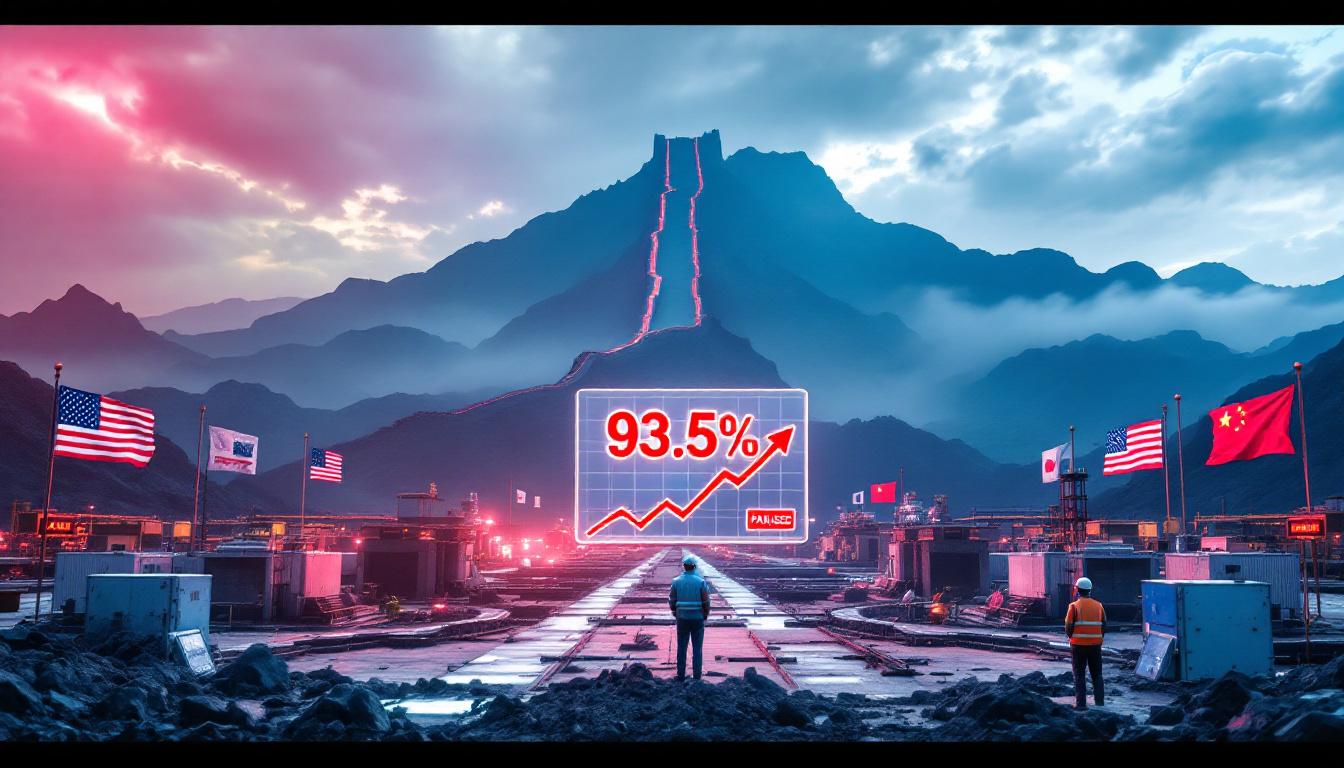The Global FLNG Revolution: How Floating LNG Capacity Will Transform Energy Markets by 2030
The global liquefied natural gas (LNG) industry is undergoing a significant transformation with floating LNG (FLNG) technology emerging as a game-changing solution. According to recent industry analysis from Rystad Energy, global floating LNG capacity is set to skyrocket by 2030, reaching an impressive 42 million tonnes per annum (Mtpa), up from just 14.1 Mtpa in 2024. This remarkable growth trajectory is expected to continue, with capacity potentially reaching 55 Mtpa by 2035—nearly quadrupling current levels.
What is Driving the Surge in Floating LNG Capacity?
FLNG technology represents a fundamental shift in how natural gas resources are developed and monetized. Unlike traditional LNG facilities that require extensive onshore infrastructure, FLNG units combine extraction, processing, liquefaction, storage, and offloading capabilities on a single floating vessel. This revolutionary approach is gaining momentum for several compelling reasons.
The Evolution of FLNG Technology
FLNG technology has matured significantly over the past decade, overcoming initial technical and operational challenges that once limited its adoption. The industry has demonstrated impressive progress in optimizing these floating facilities:
- Terminals commissioned before 2024 have achieved an average utilization rate of 86.5% in 2024 and 76% to date in 2025
- These utilization rates now rival those of conventional onshore LNG facilities
- Operational reliability has improved dramatically across various marine environments
- Engineering advancements have addressed early design limitations and performance issues
As Kaushal Ramesh, Vice President of Gas & LNG Research at Rystad Energy, explains: "FLNG has come a long way in less than a decade. The only real roadblocks were early teething issues that come with any new technology, as seen with projects like Shell's Prelude, which faced cost overruns and unstable output. But since then, the industry has matured significantly, including Prelude itself. Utilization rates are improving, the technology is proving reliable across a range of environments, and the economics are starting to make more sense."
Economic Advantages Driving Adoption
The economic case for FLNG has strengthened considerably as the technology has matured:
- Capital costs have declined significantly through standardization and experience
- Project timelines have compressed from approximately 4.5 years for onshore facilities to just 3 years for FLNG newbuilds
- Financing risks are reduced due to shorter construction periods and modular development approaches
- Previously stranded gas resources can now be economically developed without costly pipeline infrastructure
- Asset mobility provides a crucial hedge against resource depletion and changing market conditions
How Have FLNG Projects Overcome Their Initial Challenges?
Early FLNG projects encountered significant obstacles that threatened the viability of the technology. Shell's Prelude FLNG in Australia became a cautionary tale, with costs ballooning to approximately $2,114 per tonne for liquefaction alone. The project also experienced unstable output and operational difficulties that dampened industry enthusiasm.
Learning From Early Mistakes
The industry has learned valuable lessons from these pioneering projects:
- Design Optimization: Engineers have refined process layouts to improve efficiency and safety
- Construction Methodology: Standardization of components has reduced custom engineering requirements
- Operational Protocols: Enhanced monitoring systems and predictive maintenance reduce downtime
- Project Management: Improved risk assessment and cost controls prevent budget overruns
- Technology Integration: Better integration of existing LNG technologies adapted for marine environments
These improvements have transformed FLNG from an experimental concept to a mainstream development option. The technological maturation process, while challenging, has created a foundation for the current surge in FLNG adoption globally.
Cost Reduction Strategies
Modern FLNG developments have implemented several strategies to dramatically reduce costs:
- Standardized Designs: Replicating successful configurations rather than reinventing each project
- Modular Construction: Building components in specialized shipyards before final assembly
- Vessel Conversions: Repurposing existing maritime assets rather than building from scratch
- Supply Chain Optimization: Developing dedicated supplier networks for specialized components
- Scale Efficiencies: Applying learnings across multiple projects within company portfolios
These approaches have created a virtuous cycle of improvement, where each successful project provides insights that benefit future developments.
What Makes FLNG More Cost-Effective Than Traditional LNG?
The economics of FLNG have improved dramatically, making it increasingly competitive with—and in some cases superior to—conventional onshore LNG facilities.
Declining Capital Expenditure
The cost structure of FLNG projects has evolved significantly, as evidenced by recent developments:
- Proposed developments along the US Gulf Coast now average around $1,054 per tonne
- The Delfin FLNG project costs approximately $1,134 per tonne
- Coral South FLNG in Mozambique reports comparable liquefaction costs of $1,062 per tonne
These figures represent a significant improvement from early projects and demonstrate that floating LNG capacity is set to skyrocket by 2030 as cost-competitiveness has entered a new era. The cost reductions stem from standardized designs, improved construction techniques, and operational efficiencies that weren't available to pioneer projects.
Vessel Conversion Advantages
One of the most cost-effective approaches involves converting existing vessels, which has yielded impressive results:
- Tortue/Ahmeyim FLNG achieved capex levels of approximately $640 per tonne
- Cameroon FLNG reduced costs to around $500 per tonne
- Southern Energy's FLNG MK II reports costs of about $630 per tonne
These vessel conversion projects demonstrate that FLNG technology can be deployed at significantly lower costs than previously thought possible, opening up development opportunities for smaller gas fields that would otherwise remain stranded.
These conversions leverage Moss-type LNG carriers with modular spherical tank designs, which simplify the integration of prefabricated liquefaction modules. With numerous Moss-type LNG tankers approaching retirement in coming years, this approach offers significant expansion potential for lower-cost FLNG solutions.
Why Are Developers Increasingly Choosing FLNG Over Onshore Facilities?
FLNG technology offers several distinct advantages that are driving its increased adoption by developers worldwide.
Speed to Market Advantages
In today's volatile energy markets, timing is critical. FLNG offers significant advantages in project execution timelines:
- Newbuild FLNG projects average completion in approximately 3 years
- This compares favorably to the 4.5-year average for onshore plants (capacity-weighted)
- FLNG vessels currently under construction have even shorter projected build times, averaging 2.85 years
This acceleration in development schedules creates substantial economic benefits through earlier revenue generation and reduced exposure to changing market conditions during the construction phase.
Flexibility Benefits
FLNG technology offers unparalleled flexibility compared to fixed infrastructure:
- Geographical Mobility: Vessels can be relocated if market conditions or resource availability changes
- Asset Redeployment: Facilities can be moved to new gas fields once initial reserves are depleted
- Commercial Adaptability: Units can be sold or repurposed if project economics shift
- Scalable Development: Capacity can be added incrementally through multiple vessels
- Risk Mitigation: The ability to physically relocate assets reduces exposure to local political or economic risks
As Rystad Energy's analysis notes, "Should certain projects stall, their vessel could be relocated or sold, demonstrating the inherent mobility and adaptability of FLNG assets."
Permitting and Environmental Advantages
Offshore facilities often face fewer regulatory hurdles:
- Reduced land acquisition complexities and community disputes
- Lower visible environmental footprint compared to large coastal industrial facilities
- Potentially streamlined permitting processes in certain jurisdictions
- Minimal onshore infrastructure requirements beyond receiving terminals
- Reduced habitat disruption compared to pipeline corridors and processing plants
These advantages can be particularly valuable in regions with strict environmental regulations or complex land-use policies, such as those related to the recent Alaska drilling policy changes.
How Are FLNG Projects Adapting to Different Operational Environments?
One of the most impressive aspects of modern FLNG technology is its adaptability across diverse operating conditions.
Diverse Deployment Scenarios
FLNG vessels have proven their operational flexibility in various settings:
- Deepwater Fields: Operations in water depths exceeding 1,000 meters
- Ultra-deepwater Environments: Projects in challenging depths of 2,000+ meters
- Near-shore Operations: Facilities operating in sheltered coastal waters
- Onshore Supply: Vessels receiving gas via pipeline from land-based fields
This operational versatility has expanded the potential application of FLNG technology across virtually all gas-producing regions globally.
Technical Adaptations
Engineers have developed specialized solutions for different operating environments:
- Advanced Mooring Systems: Turret mooring systems that allow vessels to weathervane in response to changing conditions
- Process Adaptations: Customized gas treatment systems for varying feed gas compositions
- Weather-Resistant Designs: Reinforced structures for cyclone-prone regions
- Safety Systems: Enhanced emergency response capabilities for remote operations
- Offloading Technologies: Specialized systems for transferring LNG to carriers in various sea states
These technical innovations have expanded the range of conditions where FLNG can operate safely and efficiently.
What Regions Are Leading the FLNG Revolution?
The global distribution of FLNG projects reveals interesting patterns in adoption and innovation, with activity spanning multiple continents.
Regional Growth Centers
Several regions are emerging as particularly important for FLNG development:
- Africa: Countries like Mozambique (Coral South FLNG) are using the technology to monetize offshore discoveries without extensive onshore infrastructure
- Asia-Pacific: Nations with archipelagic geography are embracing FLNG to develop scattered gas resources
- North America: The US Gulf Coast is seeing multiple proposed developments averaging $1,054 per tonne despite challenges in US oil production decline
- West Africa: Projects like Cameroon FLNG and Tortue/Ahmeyim demonstrate the region's embrace of the technology
Each region brings unique advantages and challenges to FLNG deployment, resulting in diverse approaches to implementation.
Case Studies of Regional Success
Notable regional success stories demonstrate the versatility of FLNG:
- Coral South FLNG (Mozambique): This $1,062 per tonne project represents a breakthrough in East African gas development, enabling monetization of offshore resources in a region with limited existing infrastructure
- Tortue/Ahmeyim FLNG (Mauritania/Senegal): With costs of approximately $640 per tonne, this project demonstrates how vessel conversion can make FLNG economically viable in frontier regions
- US Gulf Coast Developments: Multiple proposed projects averaging $1,054 per tonne show how FLNG can complement existing gas infrastructure in mature markets
These regional variations highlight how FLNG technology can be adapted to diverse geological, regulatory, and market conditions.
What Are the Future Trends in FLNG Technology?
The FLNG sector continues to evolve, with several emerging trends likely to shape its future development.
Technological Innovations
Several technological advances are improving FLNG capabilities:
- Enhanced Liquefaction Efficiency: New refrigeration cycles and heat exchange technologies
- Digital Twins: Advanced simulation models for predictive maintenance and operational optimization
- Automation: Increased use of AI and robotics to reduce staffing requirements
- Environmental Technologies: Improved emissions control and carbon capture systems
- Modular Scalability: Standardized components that can be assembled in different configurations
These innovations are extending the operational capabilities of FLNG vessels while simultaneously reducing costs and environmental impacts.
Market-Driven Adaptations
The industry is also responding to changing market dynamics:
- Smaller-Scale Units: Purpose-built vessels for smaller gas fields or regional markets
- Multi-Purpose Designs: Facilities that can handle both production and regasification
- Integration with Renewables: Hybrid power systems combining natural gas with solar or wind generation
- Hydrogen Capabilities: Next-generation vessels designed with potential for hydrogen production
- ESG Enhancements: Improved environmental monitoring and social impact management
These adaptations position FLNG technology to remain relevant as energy markets evolve toward lower-carbon solutions, even as OPEC market influence continues to shape global energy dynamics.
How Will FLNG Impact Global LNG Markets?
The rapid expansion of FLNG capacity will have significant implications for global LNG markets and trade patterns.
Supply Chain Impacts
FLNG is reshaping LNG supply chains in several ways:
- Resource Access: Enabling development of previously stranded gas resources
- Market Diversification: Creating new supply sources outside traditional exporting regions
- Supply Flexibility: Vessels can be deployed quickly to address regional shortages
- Transportation Optimization: Potential reduction in shipping distances through strategic deployment
- Infrastructure Requirements: Decreased need for fixed export terminals and associated pipelines
These changes are creating a more resilient and responsive global LNG supply network.
Market Competition Effects
The growth of FLNG is intensifying competition in global LNG markets:
- Increased Market Participation: Lower capital requirements enable more companies to enter the LNG export business
- Price Pressure: Additional supply options may create downward pressure on LNG prices
- Contract Innovation: Greater supply flexibility enables new contractual structures
- Market Responsiveness: Faster project development allows quicker response to market signals
- Regional Market Development: Enabling gas monetization in regions previously unable to access export markets
These competitive effects will likely accelerate the ongoing transformation of global LNG markets from regional to truly global trading, further influenced by decisions made at recent OPEC production meetings.
What Challenges Remain for FLNG Development?
Despite its growing success, FLNG technology still faces several challenges that could impact its future growth trajectory.
Technical Limitations
Some technical constraints continue to affect FLNG deployment:
- Weather Vulnerability: Operations can be disrupted by severe weather conditions
- Storage Capacity: Limited onboard storage compared to large onshore facilities
- Maintenance Complexity: Performing major maintenance in offshore environments
- Production Scale: Individual vessel capacity remains smaller than world-scale onshore plants
- System Integration: Challenges in optimizing multiple systems in limited space
Industry engineers continue to work on solutions to these technical challenges, gradually expanding the operational envelope of FLNG technology.
Economic Uncertainties
Economic factors could influence the pace of FLNG adoption:
- Price Volatility: Fluctuating LNG prices affect investment decisions
- Energy Transition: Uncertainty about long-term natural gas demand in decarbonizing economies
- Financing Challenges: Some lenders remain cautious about FLNG technology
- Competition from Renewables: Increasing cost-competitiveness of alternative energy sources
- Regulatory Risks: Potential for changing regulations affecting natural gas production and use
Disclaimer: The projected growth of FLNG capacity and its economic impact involves forecasting that is inherently subject to uncertainty. Actual outcomes may differ significantly based on market conditions, technological developments, and regulatory changes.
These economic factors require careful consideration in investment decisions, with scenario planning becoming increasingly important for FLNG project developers.
FAQ: Understanding the FLNG Revolution
What exactly is FLNG technology?
Floating Liquefied Natural Gas (FLNG) refers to offshore facilities that extract, process, liquefy, store, and transfer natural gas entirely at sea. These floating facilities eliminate the need for pipelines to shore, gas processing plants, and onshore LNG export terminals, allowing for the development of offshore gas fields that would otherwise be economically unfeasible.
How does FLNG compare to traditional LNG in terms of environmental impact?
FLNG facilities generally have a smaller physical footprint than equivalent onshore infrastructure. They eliminate the need for long pipelines and extensive onshore construction, potentially reducing habitat disruption. However, they still involve fossil fuel production and face similar challenges regarding methane emissions and energy consumption for the liquefaction process.
What are the main financial risks associated with FLNG projects?
Key financial risks include cost overruns during construction (though these have decreased as the technology matures), operational disruptions due to weather or technical issues, market price volatility affecting revenue streams, and potential stranded asset risk as the world transitions toward lower-carbon energy sources.
How does FLNG fit into the energy transition?
FLNG can play a transitional role in the shift toward cleaner energy systems. Natural gas produces fewer emissions than coal when burned for electricity, and FLNG enables access to previously stranded gas resources. Some newer FLNG designs are also being developed with potential future conversion to handle hydrogen or ammonia production, aligning with longer-term decarbonization goals.
What makes vessel conversion more cost-effective than newbuild FLNG?
Vessel conversion leverages existing assets, particularly Moss-type LNG carriers with their distinctive spherical tanks. These vessels can be repurposed at significantly lower costs ($500-640 per tonne) compared to newbuilds, as demonstrated by projects like Cameroon FLNG and Tortue/Ahmeyim. The modular design of these vessels simplifies the integration of liquefaction equipment, according to [recent analysis by
Ready to Stay Ahead of Major Mineral Discoveries?
Discover how to capitalise on significant mineral finds before the market catches up with Discovery Alert's proprietary Discovery IQ model, delivering real-time ASX announcement analysis and actionable trading opportunities. Explore historic returns from game-changing discoveries at Discovery Alert's dedicated discoveries page and position yourself for investment success.




